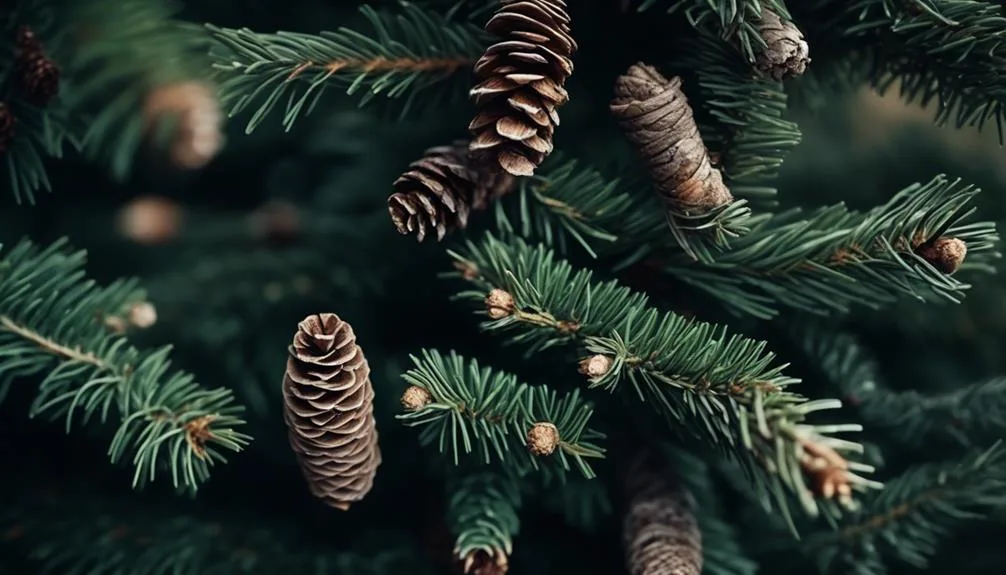Walking through a forest filled with tall spruce trees, you might have wondered if they are all edible. Before you consider eating them, it's important to know that not all spruce trees are safe for consumption. So, which ones can you eat, and what parts are edible?
Let's explore the world of spruce trees and their culinary potential.
Identifying Edible Species of Spruce
To identify edible species of spruce, carefully examine the needle clusters and cones to ensure you're selecting a safe and suitable variety for consumption. Look for spruce trees with soft, flexible needles and small, young cones. Avoid trees with hard, sharp needles and large, old cones, as these may indicate a different, potentially unsafe species.
When foraging for spruce, it's important to positively identify the tree before harvesting any parts for consumption. Once you've found the right spruce species, there are various ways to enjoy it. Try incorporating spruce tips into recipes like syrup, tea, or even baked goods for a unique and flavorful twist.
To preserve this wild food, consider drying the needles for later use in cooking or making spruce-infused oils for added flavor to your dishes.
Edible Parts of the Spruce Tree
The edible parts of the spruce tree include the tender new growth, such as the young shoots and tips, which can be used in various culinary applications to add a unique and aromatic flavor to your dishes.
When foraging for edible spruce parts, keep these tips in mind:
- Tender Shoots: Look for bright green, pliable young shoots in the spring, as these are the most tender and flavorful.
- Tips: The soft, light green tips of the spruce branches are packed with citrusy notes and can be used as a garnish or infused into syrups and oils.
- Pollen: Spruce pollen is edible and can be collected in spring, adding a delicate floral note to dishes.
- Resin: While not commonly used, the resin can be harvested and used sparingly in cooking for a unique pine flavor.
Identifying edible plants and mastering foraging tips can elevate your culinary adventures with spruce trees.
Nutritional Benefits of Consuming Spruce
Picking tender shoots and tips from spruce trees not only adds unique flavors to your dishes but also introduces a range of nutritional benefits to your diet. These young spruce tips are packed with essential nutrients, including a high concentration of vitamin C, which can help support your immune system and promote healthy skin.
Additionally, they contain antioxidants that can aid in reducing inflammation and fighting free radicals in the body. When compared to other edible coniferous trees, such as pine or fir, spruce tips have a milder, slightly citrusy taste, making them versatile for culinary use.
Historically, spruce tips have been used by indigenous peoples for their medicinal properties. Learning proper foraging techniques ensures sustainable harvesting while connecting with the historical uses of this natural resource.
Precautions When Eating Spruce
When consuming spruce, it's important to be aware of potential allergic reactions, as some individuals may experience sensitivity to certain compounds present in the tree.
To ensure your safety when eating spruce, consider the following precautions:
- Potential Toxins: Be mindful that some parts of the spruce tree, such as the needles and bark, may contain toxins that could cause adverse reactions when ingested.
- Allergic Reactions: Watch out for any signs of allergic reactions, such as itching, swelling, or difficulty breathing, and seek immediate medical attention if these symptoms occur.
- Safe Preparation Techniques: If you decide to consume spruce, ensure that it's properly prepared to minimize potential risks. This may involve cooking or processing the tree parts before consumption.
- Consultation: If you have any concerns about eating spruce or if you have known allergies, consult a healthcare professional before including spruce in your diet.
Always prioritize your safety and well-being when experimenting with new food sources.
Culinary Uses of Edible Spruce Parts
To elevate your culinary creations, consider incorporating edible spruce parts, such as the tender young shoots and flavorful needles, into your dishes for a unique and aromatic twist. Spruce tips can be used in a variety of cooking techniques, including infusions, syrups, and pickling. The bright, citrusy flavor of spruce pairs well with ingredients like citrus fruits, juniper berries, and honey, adding depth to dishes like marinades, sauces, and even baked goods. Below is a table to provide a quick reference for cooking techniques and flavor pairings when using edible spruce parts.
| Cooking Techniques | Flavor Pairings |
|---|---|
| Infusions | Citrus fruits, honey |
| Syrups | Berries, vanilla |
| Pickling | Juniper berries, garlic |
| Baking | Cinnamon, nutmeg |
Conclusion
Incorporating spruce into your diet offers a range of culinary possibilities. From tender tips to inner bark, there are various parts of the spruce tree that can be used in cooking. However, it is important to remember to identify the species of spruce you are using and take necessary precautions. Once you have done that, you can embrace the nutritional benefits that spruce provides and enjoy foraging and cooking with it. It's exciting to think about what other culinary treasures nature has in store for us.
Mark Hoffman is a dedicated arborist and tree care specialist with over a decade of experience. His love for trees began when he visited Yosemite National Park as a teenager and was awestruck by the giant sequoias. Mark pursued his passion by studying forestry at Michigan Technological University, where he earned a Bachelor of Science degree.
Since then, he has worked tirelessly in the field of arboriculture, helping to preserve and protect trees in his community. His expertise and dedication have made him a respected leader in the industry and a valuable resource for anyone seeking advice on tree care.
